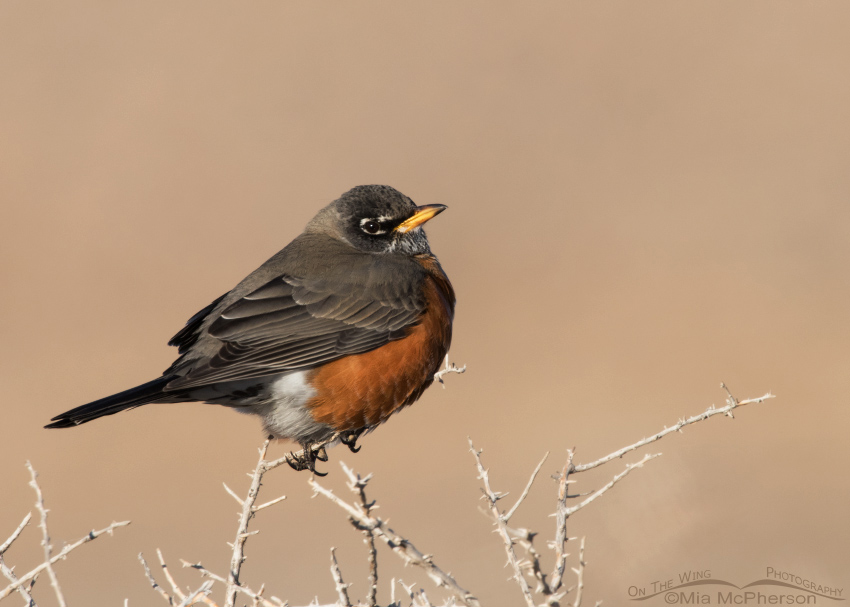 Winter American Robin – Nikon D810, f9, 1/640, ISO 500, +0.3 EV, Nikkor 500mm VR with 1.4x TC, natural light, not baited
Winter American Robin – Nikon D810, f9, 1/640, ISO 500, +0.3 EV, Nikkor 500mm VR with 1.4x TC, natural light, not baited
American Robins were first described by Carl Linnaeus in 1766 the species name Turdus migratorius. Turdus is the Latin word for “thrush” and migratorius comes from the Latin word migare which means “to go”. In many parts of North America American Robins are migratory though in some locations they are year round residents. Here in Utah I see them year round. I photographed this adult American Robin as it perched on a greasewood on Antelope Island State Park.
During the warmer months American Robins start to sing long before sunrise and if you have a window open you might even curse them because their dawn song goes on and on and on. I love that song… as long as they aren’t right outside my window when I am trying to sleep.
Three states call the American Robin their state bird and quite a few songs have been written which feature them in the lyrics and they are also considered the harbingers of spring. American Robins are spoken about in Native American legends where the story is told that they got their red breast by fanning the dying flames of a fire to save a native American man and a child.
Personally, I love to see American Robins any time of the year and to watch them searching for prey. Common? Yes, they are abundant but they are delightful too.
Life is good.
Mia
Click here to see more of my American Robin photos plus facts and information about this species.


Your comment about dawn reminds me of the Emily Dickinson poem:
“The robin is the one
That interrupts the morn
With hurried, few, express reports
When March is scarcely on.
I so love Robins, common though they are in Seattle. I am especially drawn to winter robins, the title of your post. During the rare Snow here, I always hope the winter berries are ripe enough to draw our local flocks for some feeding among the snowflakes.
Your photo reminds me of something I always enjoy visually about Robins (and many birds, I suppose) — their ability to so quickly alter their appearance. Just as Steller’s Jays move their crests and taken on an entirely new expression, robins seem alternately lean and tall, or short and composed as here.
Birds are just wonder, what can I say? And your images of them even better.
(sorry for the late-night typos)
Great image — reminds me of the Robins I saw in England, called English Robins or European Robins, which do not migrate and are only 5 to 5.5 inches long.
Found this interesting bit on Wikipedia: The distinctive orange breast of both sexes contributed to the European robin’s original name of redbreast (orange as the name of a colour was unknown in English until the sixteenth century, by which time the fruit of that name had been introduced). In the fifteenth century, when it became popular to give human names to familiar species, the bird came to be known as robin redbreast, which was eventually shortened to robin.[5] Other older English names for the bird include ruddock and robinet. In American literature of the late 19th century, this robin was frequently called the English robin.[6]
We are seeing great numbers of robins move south through Chicago currently. I enjoyed reading about the Indian legend concerning Robins. Beautiful photograph, as always, Mia!
I wonder whether they are as noisy and insistent as our wattle birds – which also start up well before sparrow-fart. I suspect their call is prettier though. And I can’t think of any bird that is too common for me to enjoy – and to learn more about.
Little sweetie! Nice picture, thank you
Love the robin, in Michigan when they appeared spring was right around the corner. Another thing I miss. living in Florida
I adore them as well. Love to see the clouds of them on the lawn in early spring . They were grouping again here the other day, I guess on their way to somewhere warmer.
Love the BG for this one. American Robins are common to abundant winter visitors and spring and fall migrants in the Pensacola area. I would like to see them more often.